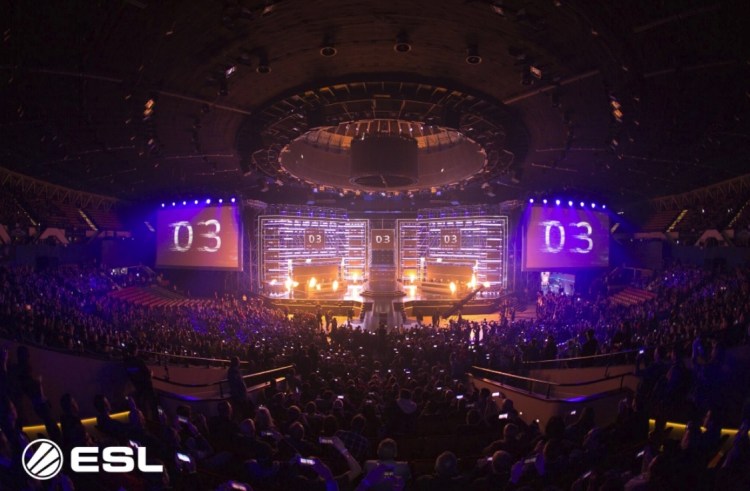Esports is in its early days, but Yvette Martinez-Rea was around during its early, early days, waiting to see when it was going to take off. But in the past year, it’s fair to say esports has exploded and that was evident at the Electronic Entertainment Expo (E3) last week.
ESL teamed up with Tencent to hold a live tournament for mobile game Arena of Valor at E3. The two-day tournament drew crowds to the corner of the South Hall of the Los Angeles Convention Center during the big game trade show, which drew 69,000 people to Los Angeles last week. The tournament was broadcast on six streaming platforms, including the Arena of Valor Twitch channel. The winners will battle in Los Angeles in July for a prize pool of $550,000.
Martinez-Rea, president of ESL North America, said in an interview at E3 that her company specializes in coordinating these kinds of events so that they draw crowds and get plenty of online attention. As esports grows from $906 million in 2018 to $1.65 billion by 2021 (according to market researcher Newzoo), and from 143 million enthusiast fans in 2017 to 250 million in 2021, Martinez-Rea said ESL will be there to handle events from hundreds of people to tens of thousands.
Here’s an edited transcript of our interview.
June 5th: The AI Audit in NYC
Join us next week in NYC to engage with top executive leaders, delving into strategies for auditing AI models to ensure fairness, optimal performance, and ethical compliance across diverse organizations. Secure your attendance for this exclusive invite-only event.

Above: Yvette Martinez-Rea is head of North America for ESL.
GamesBeat: Esports is hot at E3, isn’t it?
Yvette Martinez-Rea: I have a stepson in his 20s. He’s like, “Can you get me in?” He never asked me before, but now it’s in his consciousness. He goes to all the comic cons, but he’s never gone to E3.
GamesBeat: [Entertainment Software Association CEO] Mike Gallagher always talks about billions of eyeballs for the show. But there’s never any action attached to that, except that six months from now you buy a game. Now you can actually do things here at E3. Does it seem like an interesting venue to you guys, as a place to have these tournaments?
Martinez-Rea: We’re still experimenting and learning. We do stuff at Gamescom and other places like that. I hear it’s even crazier there, although I’ve never been. There are unique challenges, technical challenges. You’re fighting with so many other installations. It’s always, who’s the audience going to be? What are they doing? How do you time what you do so they’re there at the booth? Every year and every game is a little bit different.
That’s why we enjoy working with Tencent. They’re very involved with us. What are we going to give away? What talent are we going to use? Who are the influencers we’re flying in? How do we make this stand out in a crowded field? They’ve been a good partner. AT&T is a good partner as well. They’re very interested in the best possible experience. It’s different from a studio show where we control all the elements and we know exactly what works.
Yesterday my team called me here and said, “A band is playing 10 feet away. We gotta figure out what time they’re playing, because if they’re playing opposite the tournament—“ Stuff like that pops up that we just don’t usually have to deal with. It makes it trickier, but also more fun. Everyone says that if you survive the E3 surprises, you can do anything.
GamesBeat: Is it just the one game, or are there several games?
Martinez-Rea: Days one and two are the Arena of Valor North American finals, and then day three is more of a showcase with Tekken and Soul Calibur, and maybe a third game.
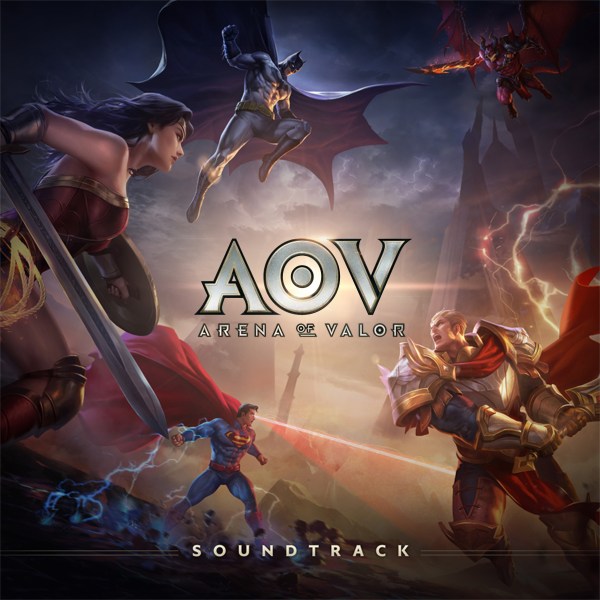
Above: Arena of Valor
GamesBeat: For the mobile side, what’s your sense of how crowded that could become? It’s hard to predict whether people are really into the mobile esports yet.
Martinez-Rea: That’s what I think. It’s not really clear yet, but there’s no question, just from having a 14-year-old kid, that this is ultimately going to be the hardware of choice. Whether the games are compelling enough yet, it’s early days. But AoV is doing a good job of focusing on their community in this market.
GamesBeat: That’s where AT&T and the 5G stuff might be a big difference.
Martinez-Rea: Yes, I agree. It’s exciting for that reason. I’d say the esports purists are pretty snobby about it. But we know already that this is going to be a thing. It’s just a matter of time. The VR area is the one where I’m a little less—you and I talked about this. I’m not sure that the content, the games, are there yet. But in mobile it’s definitely coming.
We just did a Clash thing for AT&T at one of their conferences. What I enjoyed was that—you had several hundred people in the audience, moms and dads, all these parents who’d never seen a Clash game. But they got into the competition. I do think it’s because their kids are sitting right next to them and saying, “Oh, I recognize that.” Mobile, you can already see that it’ll have a broader audience from a spectator perspective.
GamesBeat: Are you guys prepared to do these things that could be smaller, like a few hundred people, versus thousands of people?
Martinez-Rea: We did that today. We call it up and down the pyramid. We do a lot of events right now with just a few hundred people in the studio or other places. Sometimes just because that’s the right thing for the title, and sometimes because that’s what the publisher wants to do. That’s the thing I like the most about ESL. We get to see games like Rainbow or whatever develop from small, mature scenes and move them up to things that start to fill larger venues.
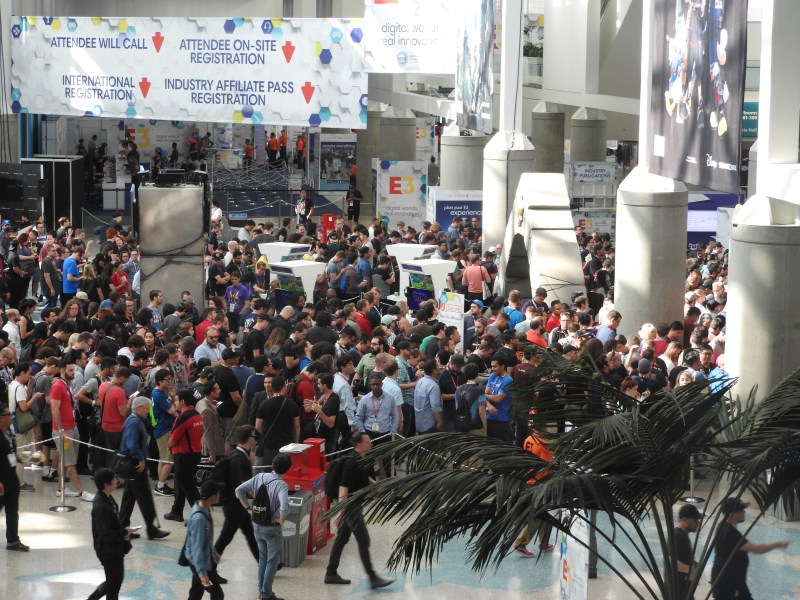
Above: The crowds at E3
GamesBeat: It’s interesting to me that nobody’s making use of Staples Center yet. That’s the biggest venue here, if you want to do a big esports show. Your only risk is crossover with the Lakers games, I guess.
Martinez-Rea: That’s been our biggest challenge. I don’t know about the Staples Center specifically, but for the guys that pick venues, especially in the U.S., the schedules are so packed. It’s hard to find the right dates to do that.
GamesBeat: They were saying that E3 would expand to the Gamescom model if they could, but they can’t get the weekend.
Martinez-Rea: Right. It’s always date-oriented. Even from last year to this year, stuff is starting on Saturday. Off in Hollywood and Santa Monica, it’s already feeling like it’s taking over the town.
GamesBeat: Do you think there are more publishers like EA, that spread of publishers that like using ESL, versus the Activisions that are doing all their own organizing?
Martinez-Rea: The little-known truth is that ESL still works with everyone in some capacity. What we hear from publishers is that they appreciate how we have a global scale, but we can do things at a smaller local level as well. We’ve been working with them for so many years in so many ways.
Even with a Riot, who we worked with in very early days—they’ve brought League in house, but they appreciate that esports is a complicated thing. It’s very different than game development. What we find is that even with the Riots of the world, when they start to appreciate the investment and the expertise that takes, they start to come back and say, “Hey, there’s something you can help us with.” We think that will keep happening.
The new publishers that are really embracing this, they’re trying to figure out the right model for esports. They know they have to go big to make it meaningful, but what does that mean? They need to focus their resources. I think Ralf’s approach, to keep ourselves agnostic, sometimes feels a little scary. But what we all say is that not only are there enough publishers and games, but even the ones that bring it close end up not having all the pieces. They come back to us.
GamesBeat: How many people do you have now?
Martinez-Rea: Globally, about 500. In the U.S., about 100. I think we now have 11 studios around the world. We all feel like that’s a good number. Obviously Asia is always a market that we’re trying to figure out. We’ve tried different things there. Otherwise it feels like 11 studios gives us something in every major area.
We’re also seeing that whereas the in-studio events were the big parts of the pie, with the 13 megas, now there’s more of an appetite for these live experiences in different places like E3. The studio footprint is great, but now the next shift is how we can activate outside of a set studio. Between that and the mega-event is the sweet spot now. The Rainbow Six finals we just did was at a casino in Atlantic City. Atlantic City had never hosted an event. They were really interested. Rainbow was really interested.
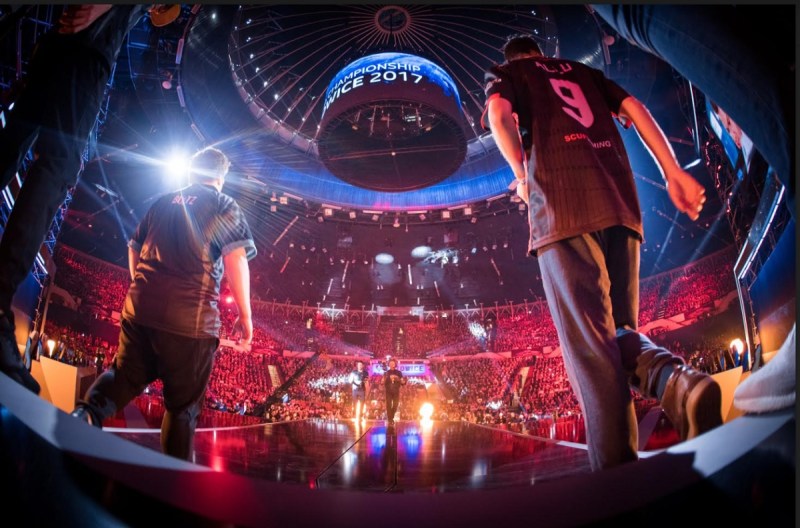
Above: The ESL esports finals for Counter-Strike: Global Offensive in Katowice, Poland, in 2017.
GamesBeat: If you were to ratchet up what you do at E3, what would that be like?
Martinez-Rea: We’re always looking at cool and different venues, different places that aren’t necessarily a theater setting. More places are coming to us wanting to do esports, especially in L.A. There’s a lot of traditional places that cater to TV and film production asking if we can activate there. There are pros and cons to it. DreamHack, our sister company, activated at a rodeo venue in Denver last year, which was a really cool place, but you can imagine that it presented its own challenges.
For us it’s so technically demanding in terms of production. It comes down to, can we find a venue that appeals to the right people, but can technically support us? Because mobile it becomes even more of a tax on the venue in some ways, which is why partners like AT&T become important.
GamesBeat: Do you guys do anything in Las Vegas?
Martinez-Rea: We’re looking at some things there now. We have done things in Vegas, a couple of years. What we found, at the time at least, is that our audience isn’t really spending the cash that it takes to go to Vegas. People said, “Oh, sure, anybody will take a weekend to go to Vegas.” But what we found is, the fans all said, “No, that’s too expensive.” It’ll be interesting to see if that’s shifted now. But at the time, you know, 14-year-olds can’t go there by themselves, and their parents aren’t going to take them.
Vegas has a lot of advantages. But what we’ve learned is that it’s all about the right game that attracts a particular audience and a venue that can work with us on that. It’s all a puzzle. The casinos are very hot. We take a lot of meetings with cities now. Every city in the world wants to build an esports arena, or convert a current one.
GamesBeat: You bring a good demographic now. Everyone wants them.
Martinez-Rea: We had people from New Zealand in the other day. They were in town for some economic conference and they wanted to come and talk about doing esports, so we connected them with the Australia team. Their demographic is pretty young, actually. It’s definitely crossed the threshold of being a thing that even governments are aware of.
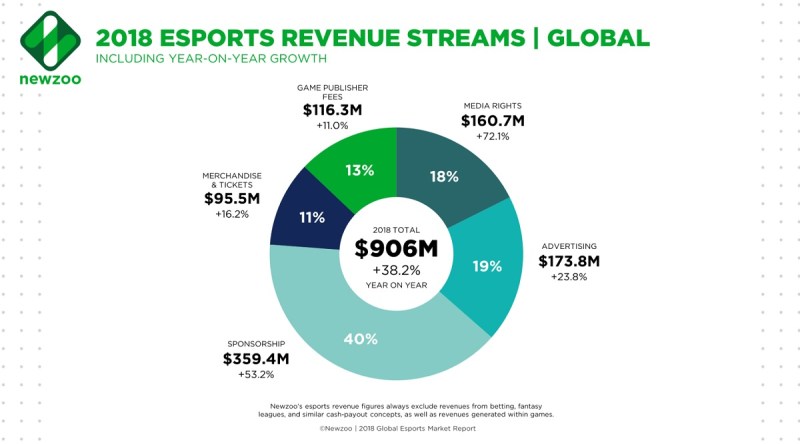
Above: Sponsorship is the biggest source of revenue for esports in 2018.
GamesBeat: Has all the attention esports has gotten in the last year prompted a change in strategy for you guys?
Martinez-Rea: It’s definitely driven us to think about where we’re going to focus the business. One of the reasons ESL has been so successful and gotten to this scale, traditionally no one else was doing a lot of this. We had to do it ourselves. There was no one else who had an ad network for esports, so we had to build it. No one else was doing sponsorships, so we built sponsorships. No one else was doing the amateur stuff. We built all of this because it didn’t exist 10 or 15 years ago.
Others are now doing those things, and so as we’ve gotten to the size we’ve gotten, the question becomes, how do we focus the business? Where do we make the big investment? We’ve learned that what we’re really good at is what we call zero to hero: taking one title, one community, focusing on the core of the core, and creating a very scalable path from amateur to professional, for the game and for the players. That takes time. We feel like what we’ve done with Counter-Strike, DOTA, and now with Rainbow, we can start to do that with other titles.
We’ll always work with publishers because we believe that they’re good for esports, but also because we like being involved at early stages with lots of titles. You never know what’s the next great esports. The reality, though, is that today only a handful have the scale. We’ll continue to hone in on those. Otherwise, we’ve definitely professionalized our client teams, our sales teams, our marketing organization. Some of these things that traditionally esports was a bit more relaxed about.
Now you need people who know how to deal with top brands, who know how to do high-level strategic business development deals. Even having PR. Two years ago when I got here we didn’t have a PR firm. We didn’t have anybody doing PR. Those kinds of things are natural investments for any company that’s getting bigger in a space that requires more professionalism.
GamesBeat: Do you think the battle royale games are going to wind up being watchable?
Martinez-Rea: That’s the question of the week. It’s absolutely watchable, in my opinion. I have a 14-year-old and an 11-year-old that play them all the time. I think the question that is yet to be answered, and that will take time to answer, is whether they’ll be competitively compelling.

Above: Esports is big, but it needs to monetize better.
GamesBeat: There’s a lot of random watching of people until you get down to the last few. Then it gets exciting.
Martinez-Rea: It’s absolutely going to be incumbent on all of us to figure out how to tell the stories. Is it about post-production as opposed to live? All of those questions are still to be answered. As a parent, I’d say that it’s visually easier to enjoy, but also conceptually, it’s a lot less complicated, at least for me, than figuring out all the elements of how to enjoy watching Counter-Strike.
GamesBeat: The part that seems complex is getting 100 people on stage.
Martinez-Rea: For sure. And how do you call the action? We’re really excited about it. Culturally there’s no question that it’s hit a nerve. It’s a lot of fun. The caution that you’ll hear from everyone on our team that’s been around for a long time is that none of these things took two years to develop the legs to have long-term viability. They all took years. We need to be patient. This might be the next hot thing, but it’s going to take a while, from our perspective, for it to have that true competitive ecosystem and for everyone to figure out how you consume it.
